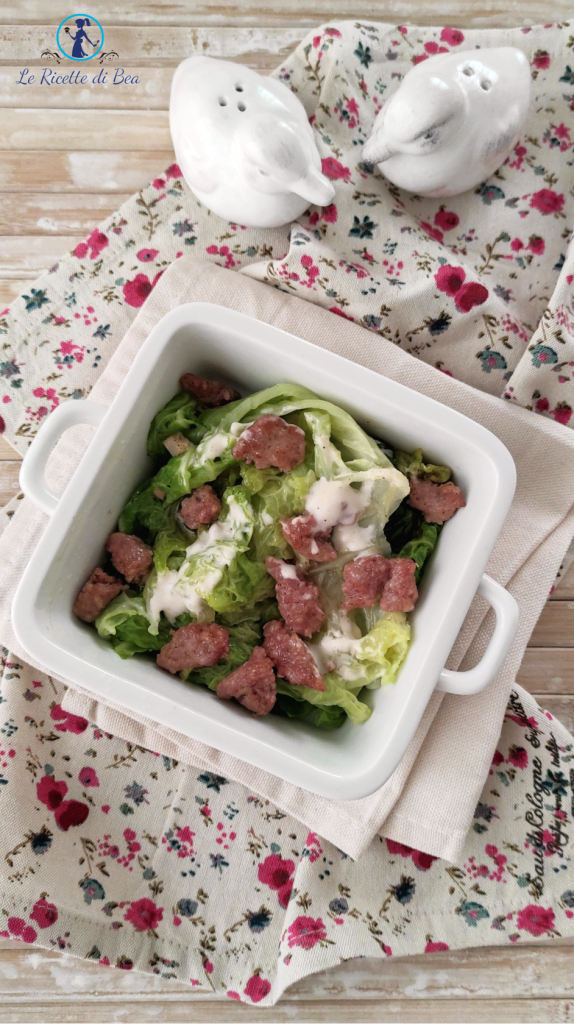The recipe for Baked Savoy Cabbage with Sausage I propose today is very simple to make but requires slightly longer preparation times compared to the usual quick side dish I generally serve for dinner. However, you will see that it is worth it; it is a dish you can serve as a side to a not too elaborate dish or as a complete main course with vegetables and cold cuts.
We ate baked savoy cabbage with sausage for dinner, needless to say, it disappeared in minutes. A tasty dish compared to the usual boiled or pan-fried vegetables, I hope you like it.
If you want to become a fan of the blog Le Ricette di Bea and not miss any content, recipes, stories, and many other curiosities from my kitchen, I await you on the Facebook fan page by simply clicking here

- Difficulty: Very Easy
- Cost: Economical
- Preparation time: 5 Minutes
- Portions: 2
- Cooking methods: Stovetop
- Cuisine: Italian
- Seasonality: Autumn, Winter, and Spring
- Energy 540.21 (Kcal)
- Carbohydrates 16.05 (g) of which sugars 7.27 (g)
- Proteins 24.18 (g)
- Fat 43.69 (g) of which saturated 1.54 (g)of which unsaturated 0.91 (g)
- Fibers 6.50 (g)
- Sodium 1,582.07 (mg)
Indicative values for a portion of 200 g processed in an automated way starting from the nutritional information available on the CREA* and FoodData Central** databases. It is not food and / or nutritional advice.
* CREATES Food and Nutrition Research Center: https://www.crea.gov.it/alimenti-e-nutrizione https://www.alimentinutrizione.it ** U.S. Department of Agriculture, Agricultural Research Service. FoodData Central, 2019. https://fdc.nal.usda.gov
Ingredients for baked savoy cabbage:
- 1 savoy cabbage
- 2 sausages
- 1 package cooking cream (optional)
- 1 pinch salt
- 1 pinch black pepper
- to taste cheese (grated (optional))
- 1.76 oz fresh spreadable cheese (of your choice: stracchino, Philadelphia, or ricotta)
- to taste golden onion (finely chopped)
Tools
- 1 Baking Tray
- 1 Pot
- 1 Knife
- 1 Teaspoon
- 1 Oven
Preparation of Baked Savoy Cabbage with Sausage:
The first thing to do is to bring water to a boil to blanch the savoy cabbage; make sure to use a little coarse salt and keep the savoy cabbage leaves whole. Don’t cut them into pieces to shorten the cooking time. Be careful not to overcook them as the leaves will start breaking, making it difficult to work with later. The taste won’t change, but the layers come out better if the leaves stay whole. Depending on the size of the leaves, let the savoy cabbage boil for at least 20 minutes on medium-low heat.
While the cabbage is cooking, prepare the sausage. Take a non-stick pan and pour some extra virgin olive oil inside and a few pieces of fresh onion. Let them wilt for a few moments, then add the pieces of fresh sausage to the pan. Cook the sausage for at least ten minutes on low heat with the lid on, adding a light sprinkle of salt and pepper only if you know the sausage you chose is not particularly flavorful; otherwise, avoid it. While the cabbage and sausage are cooking, preheat the oven to 356°F in static mode.

Once the savoy cabbage is cooked, drain it in a vegetable strainer and rinse it under cold tap water for a few moments.
Now take our baking tray and moisten the bottom with a tablespoon of cooking cream (if you chose this option) or with a drizzle of extra virgin olive oil. Form the first layer with the savoy cabbage, scatter the sausage pieces, and sprinkle with grated cheese or spreadable cheese like stracchino, Philadelphia, or ricotta of your choice. Small portions are enough; it shouldn’t make our side dish too heavy. Continue this way until you run out of ingredients. Finally, I sprinkled a bit of salt (I tasted the cabbage, and it needed it), a sprinkle of pepper, and a teaspoon of cream.
Bake for a maximum of 20 minutes.
Enjoy your meal!!!

Notes:
As mentioned during the recipe, be careful not to overcook the savoy cabbage; otherwise, it becomes mushy, and you won’t be able to make the layers well.
Second tip: do not choose a sausage too flavorful or vice versa; in the first case, you will have a taste that overpowers the cabbage, in the second, you will need to add lots of salt and pepper.
Third advice: you can add grated cheese either in the layers or on top of the “savoy cabbage lasagna,” just make sure it’s not too salty pecorino; otherwise, it might be too flavorful or unpleasant to the palate.
Storage:
As grandmothers teach, cooked savoy cabbage should not be kept at room temperature or in the refrigerator for too long, even if well closed in the container, so if you have prepared too much and have one or two portions of baked savoy cabbage left over, you can freeze it safely. Of course, only when it is completely at room temperature.
Other recipes with savoy cabbage:
If you like savoy cabbage and, like me, try to take advantage of it when it’s in season, try these tasty Savoy Cabbage Rolls, always with sausage or with ground meat, accompanied by nice mashed potatoes! You can read the recipe by clicking here.

